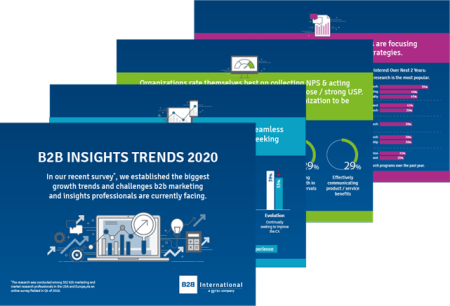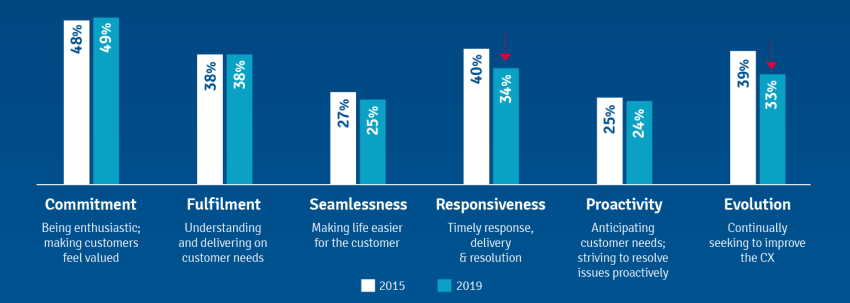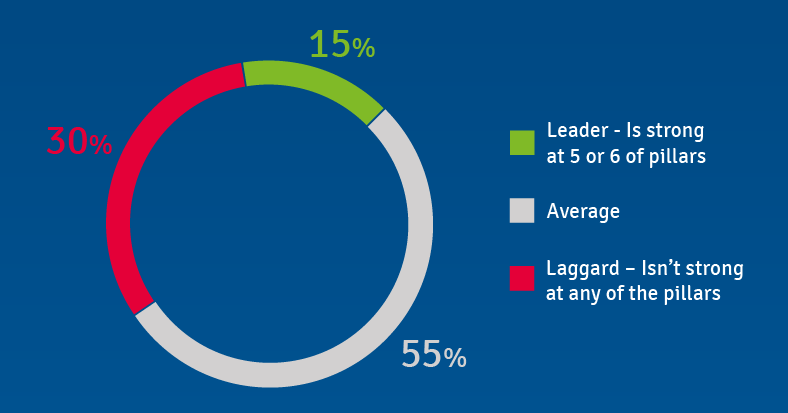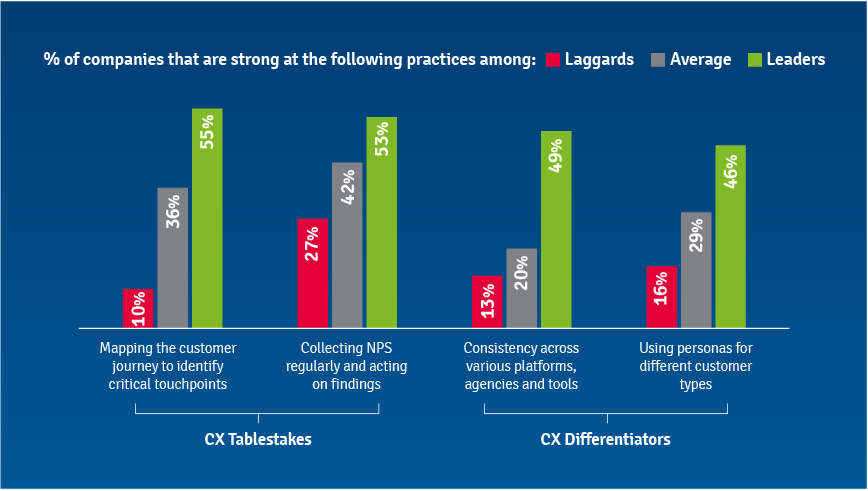
“Get closer than ever to your customers. So close that you tell them what they need well before they realize it themselves.” – Steve Jobs, Apple
Insights
According to McKinsey, improving a customer experience from average to exceptional (where the customer is “wowed” in some way) can lead to a 30 to 50 percent increase in KPIs such as likelihood to renew or to purchase another product.
However, among the top challenges faced by B2B brands is “delivering excellent customer experiences throughout the entire customer lifecycle”, cited by more than half (52%) of B2B marketers and researchers responding to the survey. This indicates that in practice, improving the customer experience is a lot more difficult than it seems.
The six pillars of customer experience excellence are B2B International’s framework for assisting B2B brands in measuring and benchmarking their performance on the critical success criteria for achieving a best in class customer experience. The chart below illustrates the performance of B2B brands surveyed, showing the proportions rating themselves strong on each attribute from both the 2015 and latest (Q4 2019) waves of the study. Not only has the share of strong performers remained remarkably flat on each customer experience pillar over this four-year period, but self-reported performance on two of the pillars actually declined significantly on the critical competencies of responsiveness (from 40% in 2015 to 34% in 2019) and evolution (from 39% in 2015 to 33% in 2019).
Percent of Companies Citing Strong Performance On The Six Pillars of Customer Experience Excellence

B2B brands perform the best on “Commitment” (being enthusiastic; making customers feel valued), although only around half rate their performance as strong on this attribute. The weakest performance is on “Proactivity” (anticipating customer needs; striving to resolve issues proactively) and “Seamlessness” (making life easier for the customer), on which only a quarter of B2B brands believe they do well.
All results combined, only 15% of B2B brands are true customer experience leaders, defined as being strong on 5 or 6 of the customer experience excellence pillars. The laggards are those lacking strong performance on any of the six pillars. Comprising 30% of the sample, there are twice as many laggards versus leaders. The balance – over half of B2B brands – falls between these two extremes in the average bucket.
Breakdown Of B2B Brands On CX Performance

Impact
Establishing a stronger customer experience is not surprisingly more challenging for the laggards because they don’t have the necessary commitment to customer centricity across their organization:
-
68% of laggards struggle delivering excellent customer experiences throughout the entire customer lifecycle.
-
54% of laggards struggle in driving consistency across various platforms, agencies and tools.
-
49% of laggards struggle connecting with customers on an emotional level to drive higher brand engagement.
Overall, the major challenge B2B marketers face in providing an exceptional customer experience is impacting their current and future strategies. 55% claim that “customer experience & loyalty” is the current marketing strategy their organization is focusing on, and the same proportion (55%) cite “customer experience research” as the research approach they expect to be most useful to their organization over the next two years. This signals a significant increase in interest surrounding customer experience research over the past year when compared to the 45% who indicated this in the prior wave of the survey, fielded in Q1 of 2019.
Elevating the customer experience is clearly a key imperative on the minds of B2B marketers and insights teams. And understandably so, given the performance metrics that lay bare a stark lack of progress made by B2B brands in embedding customer experience best practices into the fabric of their companies.
Action
In this age of the experience economy, customers expect more than ever before. It is not enough for B2B brands to deliver a strong customer experience; rather it needs to be exceptional to keep customers loyal and the competition out.
The survey results shed light on what distinguishes the leading B2B brands on customer experience, indicating what B2B marketers and insights professionals need to do to help their brands get ahead. While the stronger brands naturally perform well on the more common practices of mapping customer journeys and collecting NPS regularly, these processes contribute towards a more average performance. The brands that qualify as “CX Leaders”, i.e., who report strong performance on at least five of the six best-practice pillars, typically exhibit “consistency across various platforms, agencies and tools” and they “use buyer / user personas to better target and communicate to different individual customer types”. This highlights the importance of an integrated and seamless marketing discipline in laying the foundation for customer experience excellence. And it reinforces the need for B2B brands to have a deep understanding of their customers at the individual level to better reach and impact their target audience.
Identifying The Distinguishing Characteristics Of Customer Experience Leaders

In addition to focusing on the customer experience differentiators, there is substantial potential for B2B brands to outperform their peers across all six pillars of customer experience excellence where at least half of B2B brands are currently underperforming. The biggest opportunities to overtake the competition are arguably the more difficult to address given the weakest performance overall:
-
Being more proactive by anticipating customer needs and striving to resolve issues before they cause customers pain;
-
Driving a more seamless customer experience by eliminating friction and reducing effort for the customer.
In summary: how to win
-
Map the customer journey for key audiences served, to identify where there is potential to enhance the customer experience.
-
Revisit the KPIs used to assess performance (NPS might not be the only, or optimal, metric), and ensure an action plan is in place to always address the results.
-
Embed the 6 pillars of CX excellence into customer experience measurement programs.
-
Seek ways to drive a more seamless customer experience, especially where the customer feels the most pain in the customer journey.
-
Identify how to be more proactive, e.g. through a voice of the customer tracker to monitor changing needs, and to establish mechanisms to prevent issues before they arise.
About the survey
B2B International’s B2B Marketing & Insight Study is based on online surveys completed by 302 B2B marketing and insights professionals at businesses across North America and Europe in Q4 of 2019. The participants work across a wide variety of sectors including knowledge based, process and construction, IT and technology, trade and services, among others. The average annual revenue of organizations responding to this survey is approximately (USD)$1 billion.
Contact Julia Doheny, President – B2B International USA, Inc.
Readers of this article also viewed:


